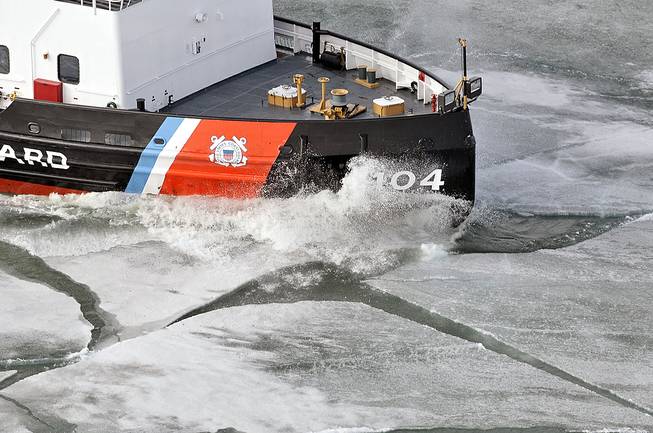
AP Photo/John L. Russell
In this Tuesday, April 22, 2014, photo, the 140-foot icebreaker Biscayne Bay cuts through thick ice on the St. Mary’s River on its way to escort vessels north to the Soo Locks, in Sault Ste. Marie, Mich. The U.S. Coast Guard spent more than four months breaking ice to open shipping lanes throughout the Great Lakes. Canada has sent two icebreakers to the High Arctic to gather scientific data in support of its plan to bid for control of the sea floor under and beyond the North Pole.
Friday, Aug. 8, 2014 | 8:40 p.m.
TORONTO — Canada has sent two icebreakers to the High Arctic to gather scientific data in support of its plan to bid for control of the sea floor under and beyond the North Pole.
The coast guard vessels Terry Fox and Louis St. Laurent set out Friday on a six-week journey that will take them to the eastern side of the Lomonosov Ridge, a long undersea feature that runs from near Ellesmere Island in Nunavut northward over the pole.
"If ice conditions permit, this survey will include areas in the vicinity of the North Pole," said a government statement.
The trip comes after Canada made a partial submission in December to the United Nations body that is considering claims from different countries to sections of the Arctic sea floor. That submission involved 1.2 million square kilometers (460,000 square miles), but Prime Minister Stephen Harper stepped in at the last minute to insist Canada extend its claim further.
Scientists have suggested it looks as if the ridge is connected to the Canadian land mass, but Canada has only done aerial surveys of the ridge once it gets past the pole.
Arctic experts point out that Russia and Denmark also argue the Lomonosov Ridge extends from their shores. The North Pole actually lies on the Danish side of the ridge, as well as on the Danish side of a line that runs equidistant between Ellesmere Island and Greenland.
The government offered no information Friday on the cost of the mission. A second mapping trip is planned in 2015.
Countries, including the U.S., are increasingly looking to the Arctic as a source of natural resources and shipping lanes. The U.S. Geological Survey says the region contains 30 percent of the world's undiscovered natural gas and 15 percent of oil.
Countries must submit proposals to the U.N. Commission on the Limits of the Continental Shelf to request an extension of their nautical borders.
If Canada's claim is accepted by the U.N. commission, it would dramatically grow its share.
The submission that Canada filed with the U.N. is essentially a series of undersea co-ordinates that map what the government claims is the country's extended continental shelf.

Join the Discussion:
Check this out for a full explanation of our conversion to the LiveFyre commenting system and instructions on how to sign up for an account.
Full comments policy